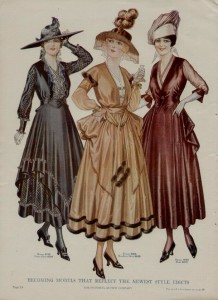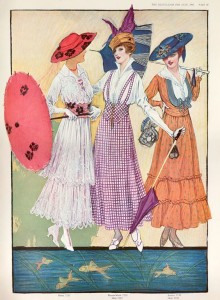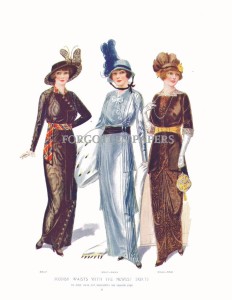How the time has flown – this fortnights column 20/8/15 will be my one hundredth edition for The Weekender Herald. http://www.weekenderherald.com.au/ It’s also been four years since the fabulous Peere who owns the paper asked me to write my ‘Style In The Hills’ publication. And since I’m celebrating one hundred columns, I thought it would be fun to look at what the ladies were up to style-wise around 1915
During the late 19th century make up was considered improper and inappropriate. But with the influence of actresses and dancers the taboos against the wearing of make up became increasingly relaxed by 1910. Women for the first time were allowed to heighten the drama of their faces and hide, as it were, their imperfections. Finally in 1915 two powerful women still know today – Elizabeth Arden and Helena Rubenstein opened their beauty salons on Fifth Avenue NY. This pave the way into the future between women and their love for make up.
Bra fashion history began in 1914 with the first bra to be patented by American Mary Phelps-Jacob – although apparently not the first bra created. Interestingly, the bra idea was just two silk handkerchiefs tied together, baby ribbon sewn on to make straps, and a seam set in the centre front. Then after 1918 fashion bras were simply lace fabric bands with straps. The bra with the best effect in those days was the ‘Symington Side Lacer’, which was a reinforced bust bodice. Side lacing meant that it flattened the bust when laced tightly, hence the word ‘brassiere’ was replaced with what we now refer to as the ‘bra’.
Surprisingly black garments were never worn by women of glamour. It was strictly the colour of mourning, and was rarely seen in evening attire. However, in 1915 you may have seen a hint of black in a fashion parade, and most likely in a shoe. The wearing black would have seemed edgy or even bizarre for this time, as only worldly women worn black. It would take another decade for the successful and powerful influence of Coco Chanel to bring the LBD into fashion prominence.
All the fashion changes that occurred around 1915 were a direct result of the great war. Women stopped wearing jewellery and lavish clothes, and the dress rules relaxed significantly for both sexes. A changing society in a young century began to challenge the rigid formality of the Edwardian styles – this would eventually lead to the knee length dress of 1926. The effect of the war on fashion styles was that belts, buckles, military braiding and shorter skirts became the norm, and for practical reasons also.
By 1914, skirts were widest at the hips and very narrow at the ankle – this was called the hobble skirt and it made taking long strides just about impossible.
”Changes in dress during WWI were dictated more by necessity than fashion. As more and more women were forced to work, they demanded clothes that were better suited to their new activities; these derived from the shirtwaists and tailored suits. A new monochrome look emerged that was unfamiliar to young women in comfortable circumstances. Women dropped the cumbersome underskirts from their tunic-and-skirt ensembles, simplifying dress and shortening skirts in one step.
By 1915, the Gazette due Bon Ton (French fashion magazine) was showing full skirts with hemlines above the ankle. These were called the “war crinoline” by the fashion press, who promoted the style as patriotic and practical”.









